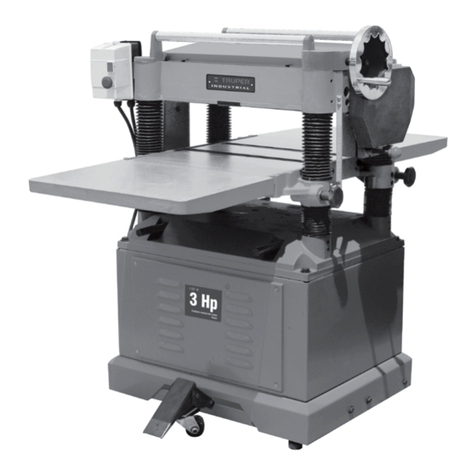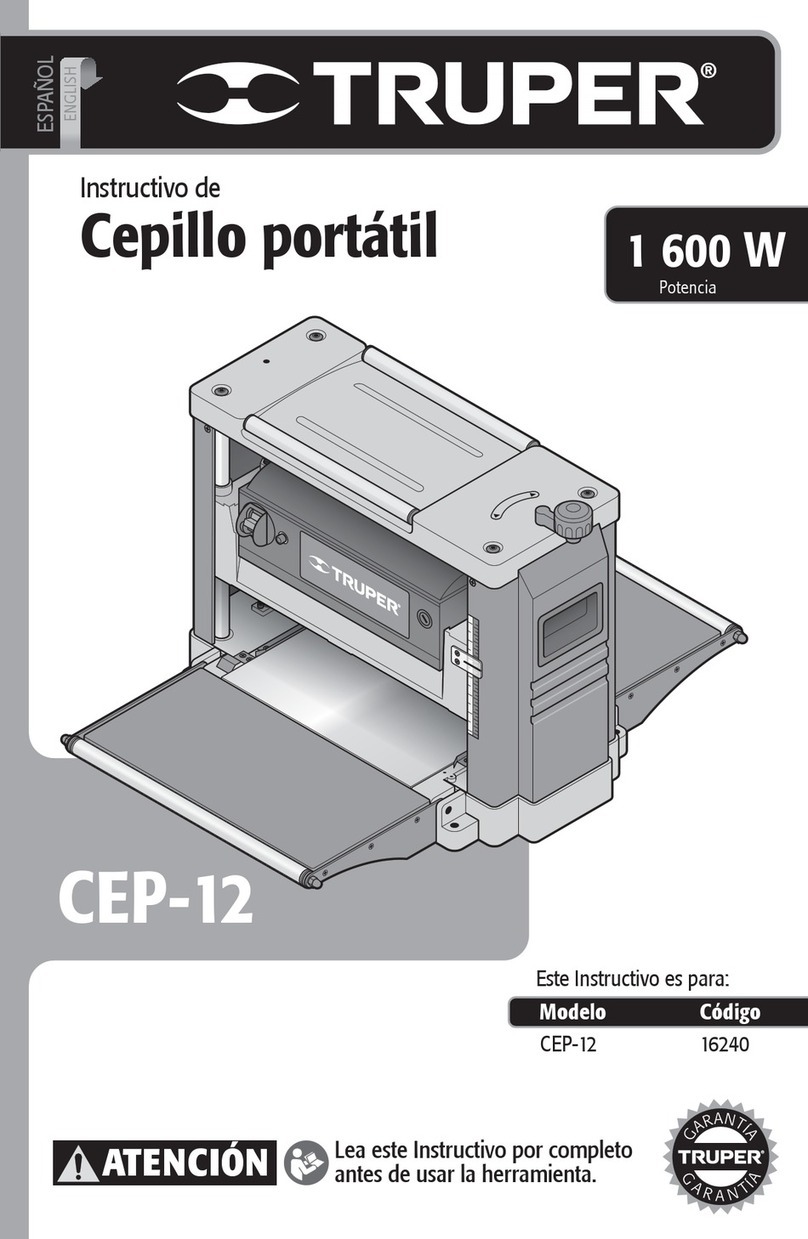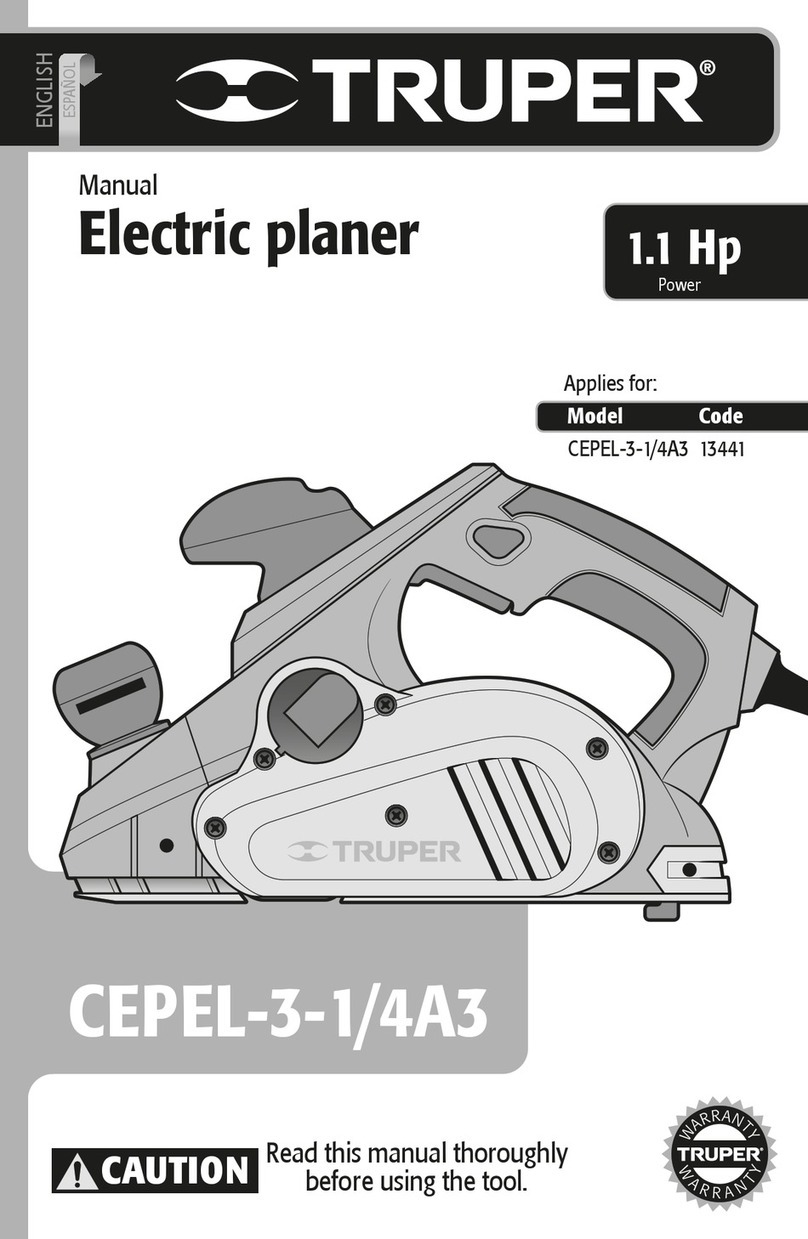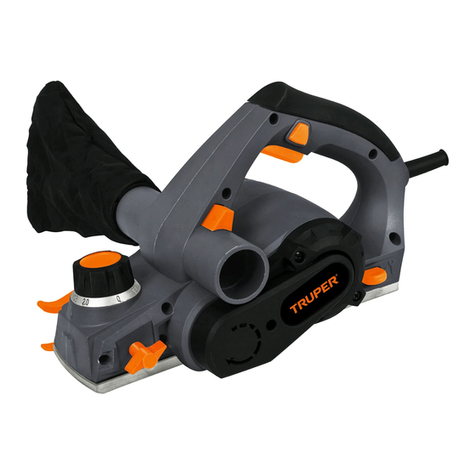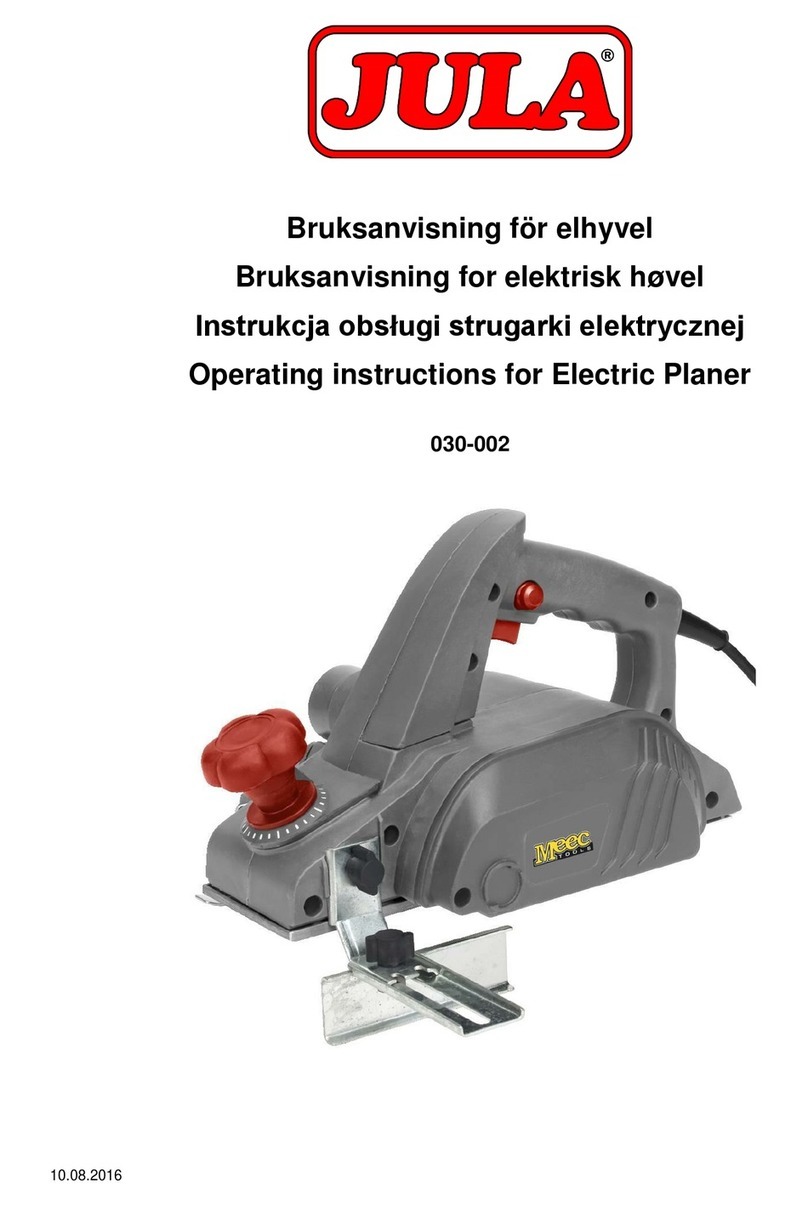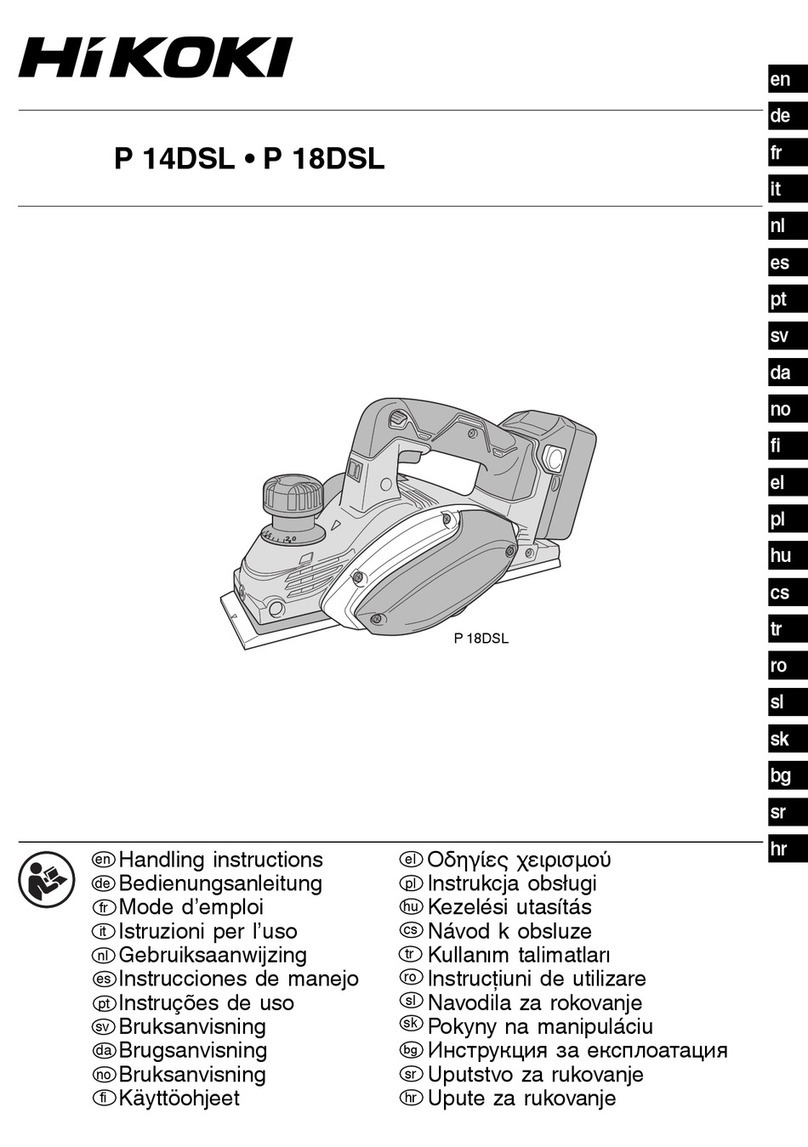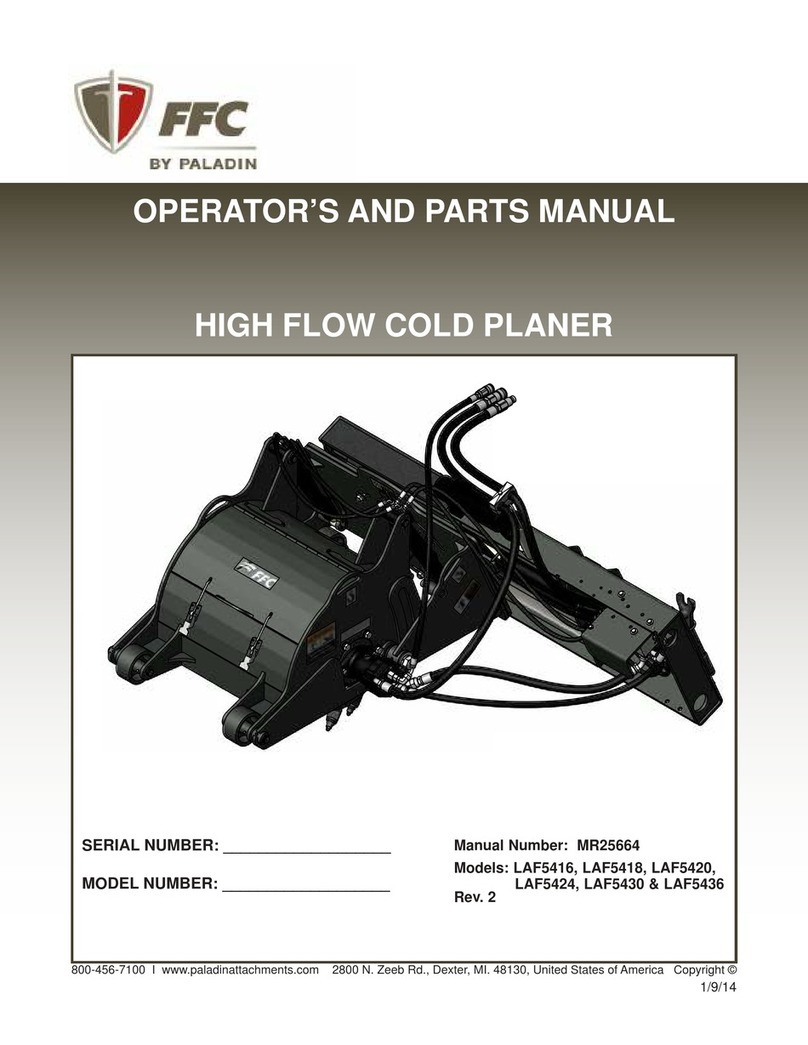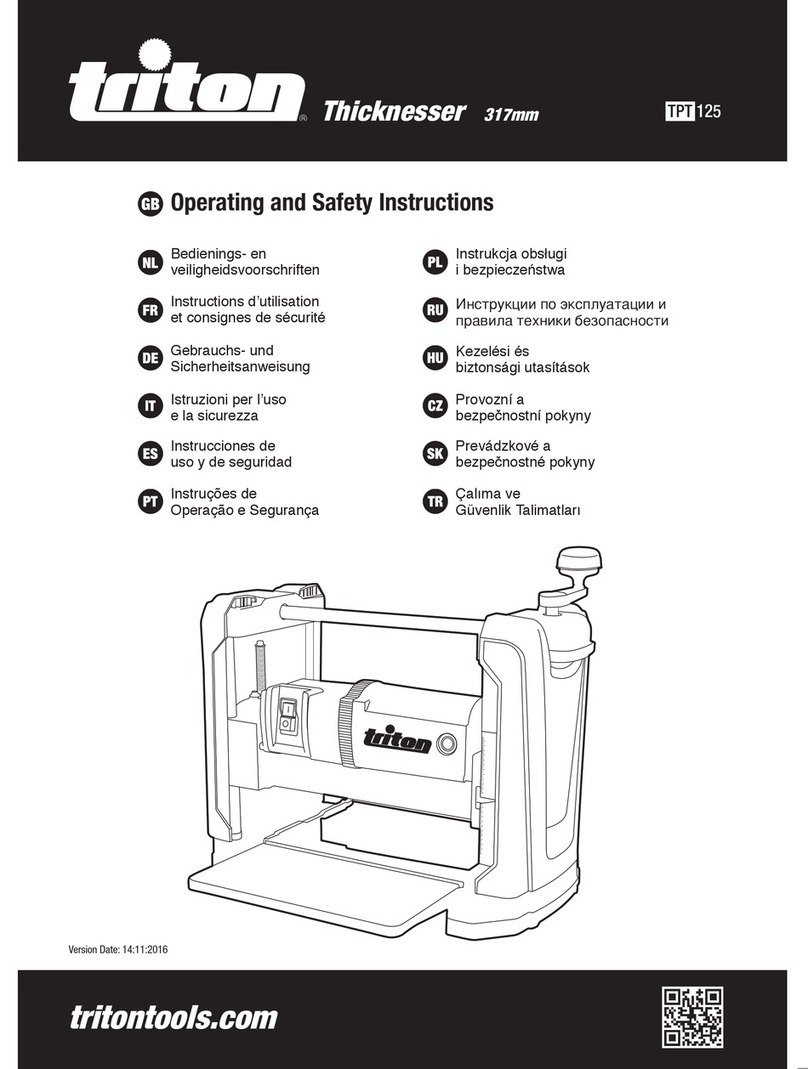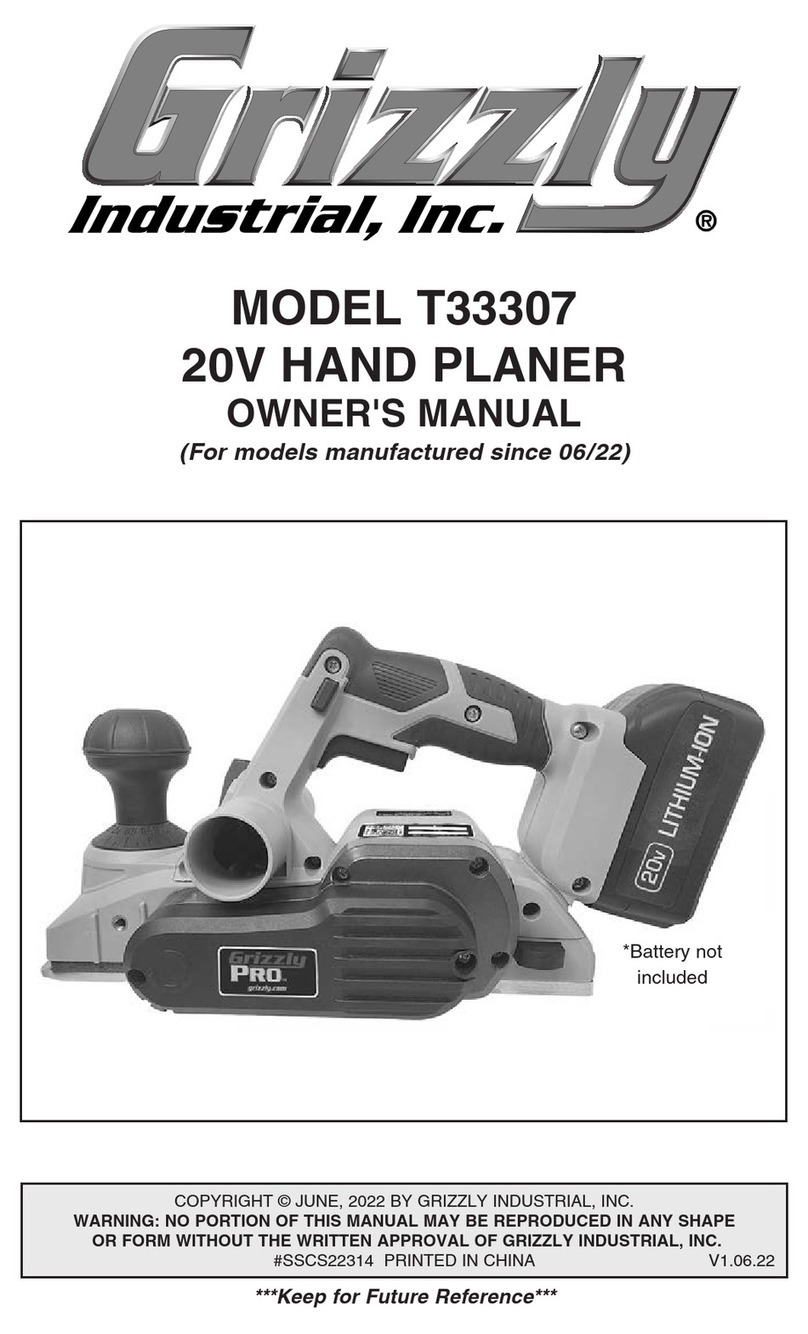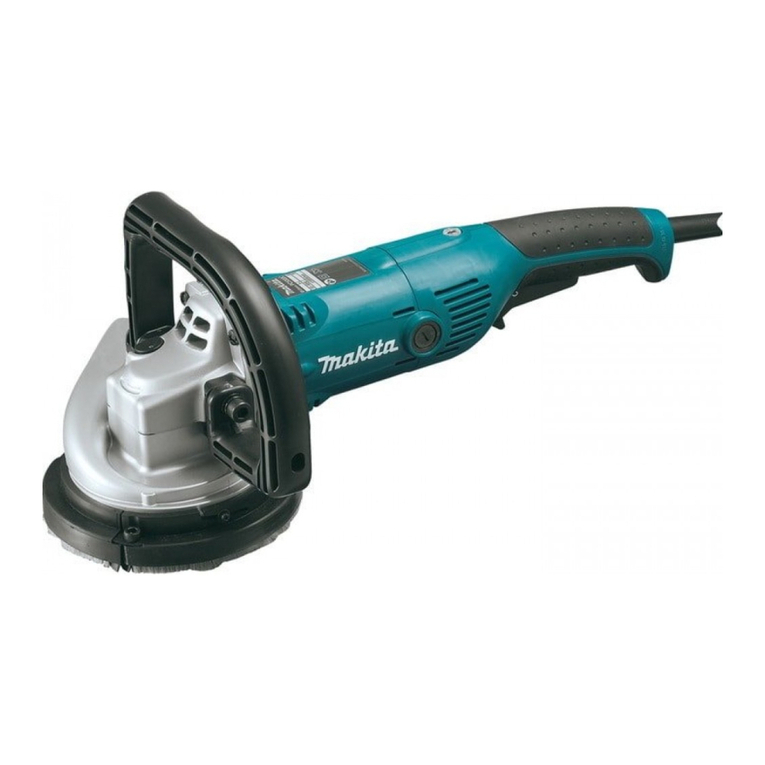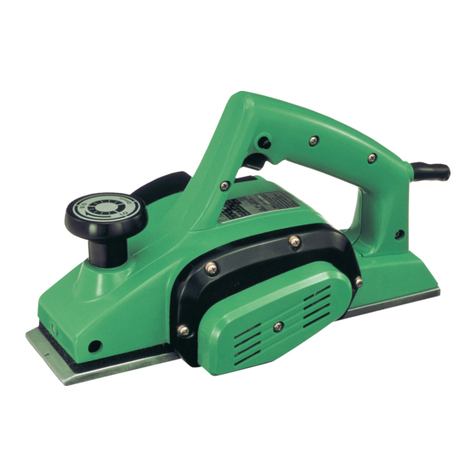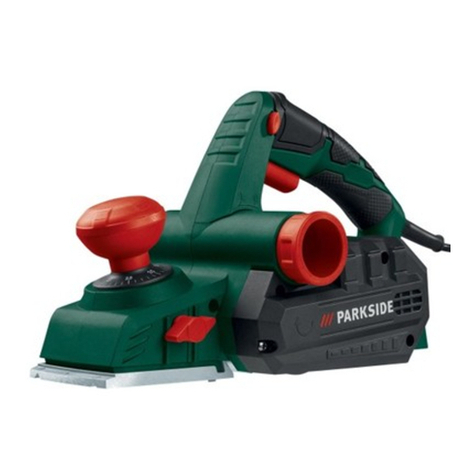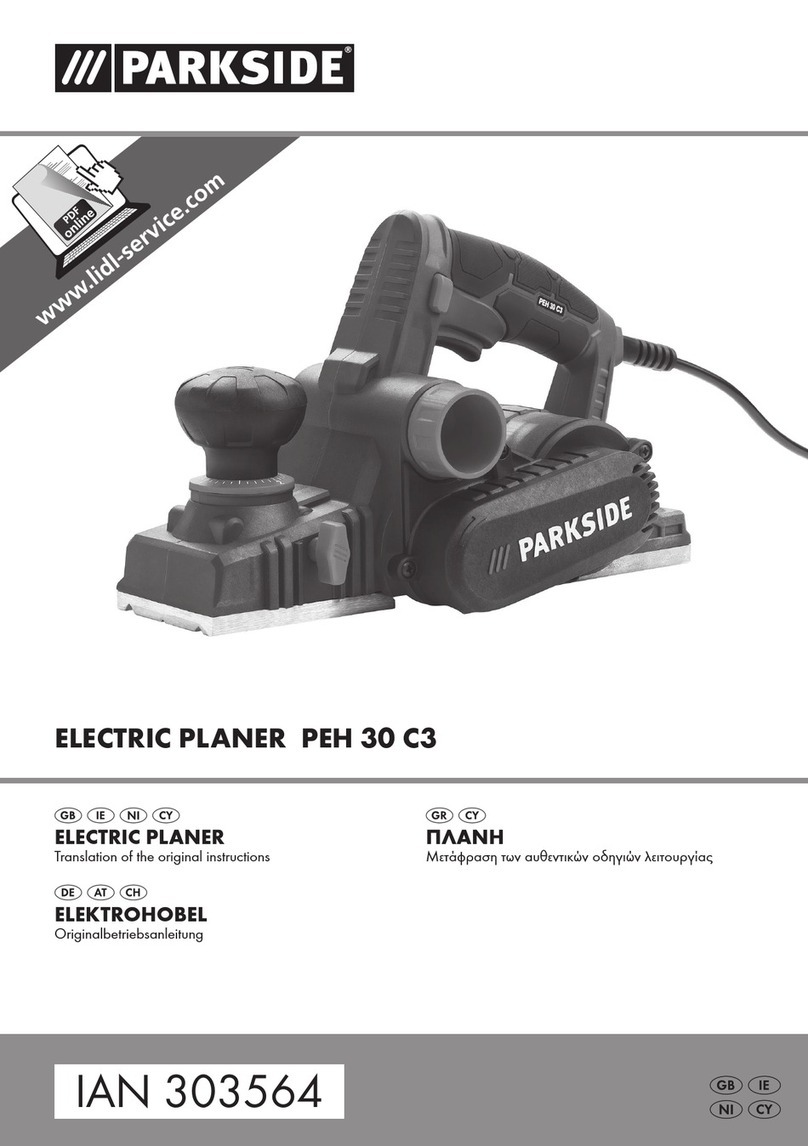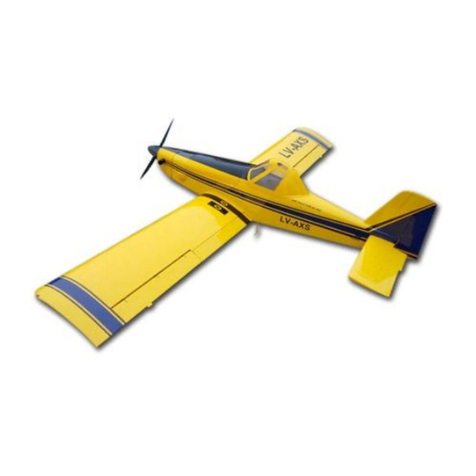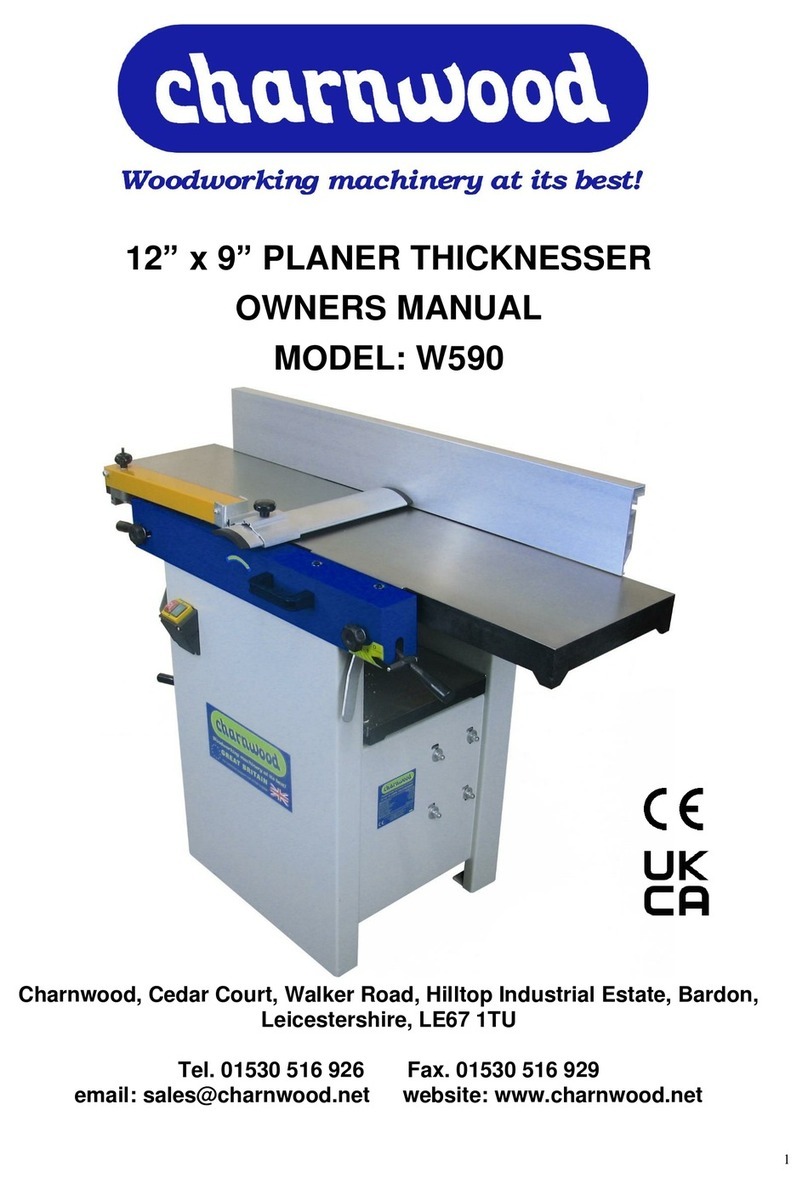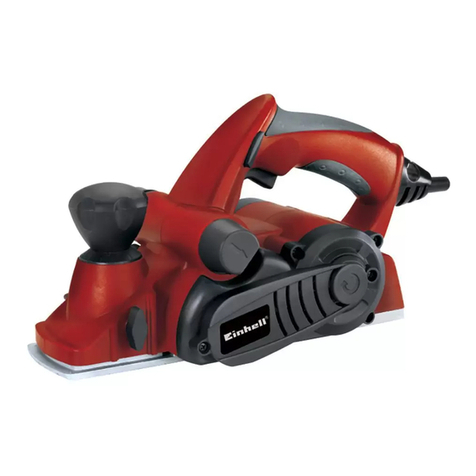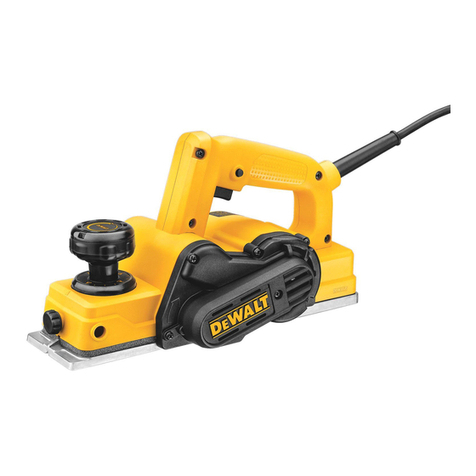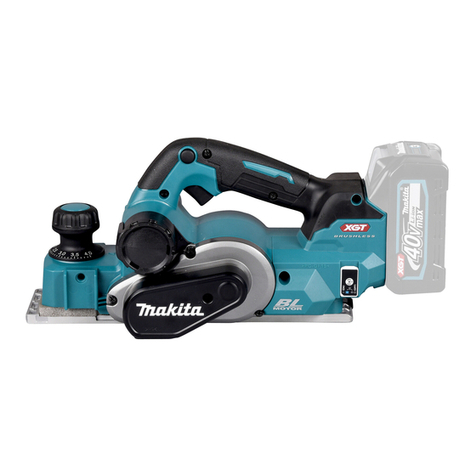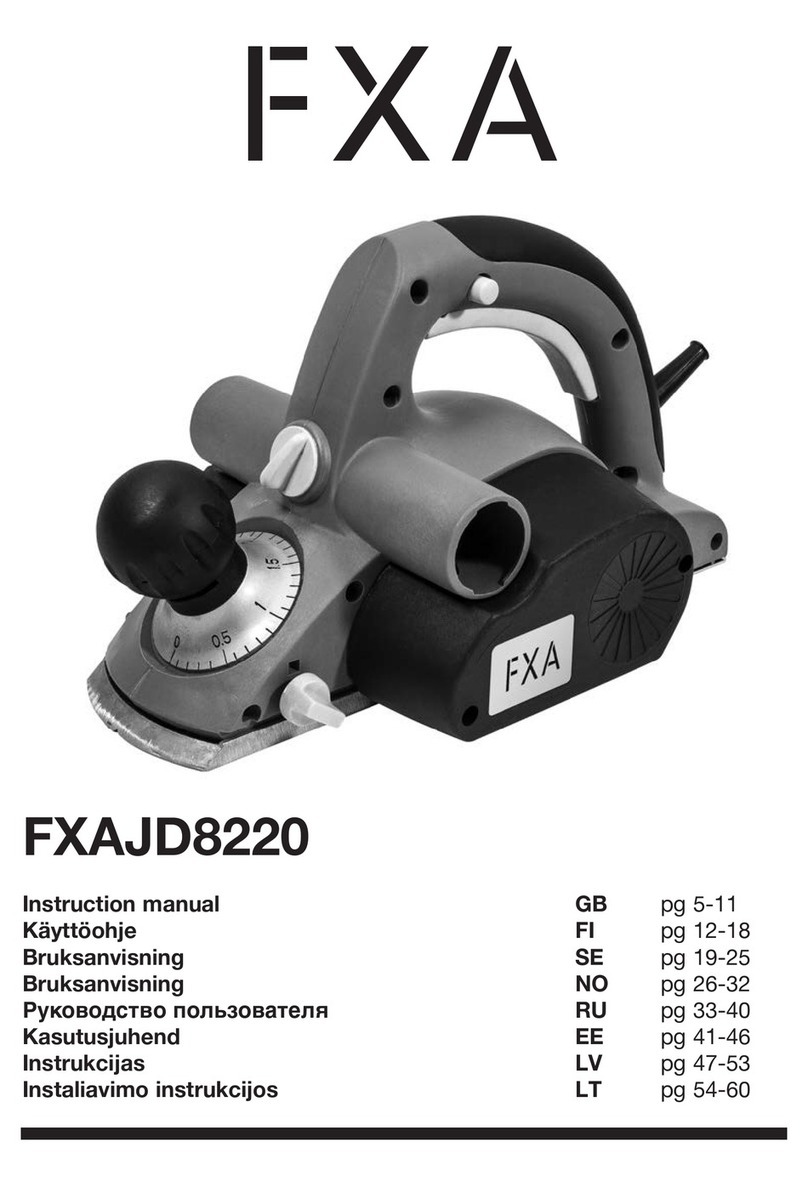Truper CEPEL-4-1/2NX User manual

Modelo Código
CEPEL-4-1/2NX
Este instructivo es para:
13089
Instructivo de
Cepillo eléctrico
CEPEL-4-1/2NX
Potencia
950 W
ESPAÑOL
ENGLISH
Lea este instructivo por completo
antes de usar la herramienta.
ATENCIÓN

Í
ndice
2
Especificaciones técnicas
Requerimientos eléctricos
Advertencias generales de seguridad
para herramientas eléctricas
Advertencias de Seguridad
para uso de cepillos eléctricos
Partes
Ensamble
Puesta en marcha
Mantenimiento
Centros de Servicio Autorizados
Sucursales
Póliza de Garantía
Guarde este instructivo para futuras referencias.
Los gráficos de este instructivo son para
referencia, pueden variar del aspecto real de la
herramienta.
3
3
4
5
6
7
7
9
10
12
12
CEPEL-4-1/2NX
Para poder sacar el máximo
provecho de la herramienta,
alargar su vida útil, hacer válida
la garantía en caso de ser
necesario y evitar riesgos o
lesiones graves, es fundamental
leer este instructivo por
completo antes de usar la
herramienta.
ESPAÑOL
ATENCIÓN

Requerimientos eléctricos
3
CEPEL-4-1/2NX
13089
50 min de trabajo por 20 min de descanso. Máximo 6 horas diarias.
Código
Ciclo de trabajo
18 AWG x 2C con temperatura de aislamiento de 105 °C
Conductores
izquierda - derecha
Sistema recolector de polvo
Profundidad: 0 mm -3 mm | Ancho: 114,3 mm (4 1/2”)
Cepillado
Clase II IP20
Grado IP
Aislamiento
El cable de alimentación tiene sujeta-cables tipo: Y
La clase de construcción de la herramienta es: Reforzada.
La clase de aislamiento térmico de los devanados del motor: Clase A
60 Hz
Cepillo eléctrico
16000 r/min
7,8 A
950 W
Descripción
Tensión
Frecuencia
Corriente
Potencia
Velocidad
120 V
Especificaciones técnicas
ESPAÑOL
Si el cable de alimentación se daña, éste debe ser reemplazado por el fabricante o Centro de Servicio
Autorizado , con el fin de evitar algún riesgo de descarga o accidente considerable.
La construcción del aislamiento eléctrico de esta herramienta es alterado por salpicaduras o
derramamiento de líquidos durante su operación. No la exponga a la lluvia, líquidos y/o humedad.
Antes de obtener acceso a las terminales, todos los circuitos de alimentación deben ser desconectados.
ADVERTENCIA
ADVERTENCIA
de 0 A hasta 10 A
de 10 A hasta 13 A
de 13 A hasta 15 A
de 15 A hasta 20 A
18 AWG(*)
16 AWG
14 AWG
8 AWG
16 AWG
14 AWG
12 AWG
6 AWG
3 (uno a tierra)
de 1,8 m a 15 m | mayor de 15 m
Capacidad en
Amperes Número de
conductores Calibre de extensión
*Se permite utilizarlo siempre y cuando las extensiones mismas cuenten con un artefacto de protección contra sobrecorriente.
AWG = Calibre de alambre estadounidense (American Wire Gauge). Referencia: NMX-J-195-ANCE-2006
Las herramientas de doble aislamiento y aislamiento
reforzado están equipadas con una clavija polarizada (una pata es más ancha que la
otra). Esta clavija cabe en cualquier enchufe polarizado y sólo puede conectarse de
una forma. Si la clavija no cabe en el enchufe, voltéelo. Si aún así no cabe, póngase
en contacto con un electricista calificado o instale un enchufe polarizado. No altere la
clavija en forma alguna. Ambos tipos de aislamiento eliminan la necesidad de un
cable de corriente de tres partes con conexión a tierra o de un sistema de corriente
eléctrica con conexión a tierra.
Al usar un cable de extensión, asegúrese de usar el calibre suficiente para transportar la corriente que
consumirá su herramienta. Un cable de un calibre inferior ocasionará caídas de tensión en la línea, teniendo como resultado
pérdida de potencia y sobrecalentamiento del motor. La siguiente tabla muestra el tamaño correcto que debe usarse
dependiendo de la longitud del cable y de la capacidad de amperes indicada en la placa de datos de la herramienta. Si tiene
dudas use el siguiente calibre más alto.
ADVERTENCIA
ADVERTENCIA
ADVERTENCIA Al operar herramientas eléctricas en exteriores, utilice una extensión aterrizada marcada
como “Uso exterior” marca . Estas extensiones son especiales para el uso en exteriores y
reducen el riesgo de sufrir una descarga eléctrica.

4
Esta herramienta cumple
con la Norma Oficial
Mexicana (NOM).
Área de trabajo
Mantenga el área de trabajo limpia y bien iluminada.
Las áreas desordenadas y obscuras son propensas a accidentes.
No maneje la herramienta en ambientes explosivos, como en
presencia de líquido, gas o polvo inflamable.
Las herramientas eléctricas producen chispas que pueden encender
material inflamable.
Mantenga alejados a los niños y curiosos cuando opere la
herramienta.
Las distracciones pueden hacer que pierda el control.
Seguridad eléctrica
La clavija de la herramienta debe coincidir con el tomacorrien-
te. Nunca modifique una clavija. No use ningún tipo de
adaptador para clavijas de herramientas puestas a tierra.
Clavijas modificadas y enchufes diferentes aumentan el riesgo de
choque eléctrico.
Evite el contacto del cuerpo con superficies puestas a tierra
como tuberías, radiadores, cocinas eléctricas y refrigeradores.
Hay un mayor riesgo de choque eléctrico si el cuerpo está puesto a tierra.
No exponga la herramienta a la lluvia o condiciones de humedad.
El agua que ingresa en la herramienta aumenta el riesgo de choque eléctrico.
No fuerce el cable. Nunca use el cable para transportar,
levantar o desconectar la herramienta. Mantenga el cable
lejos del calor, aceite, orillas afiladas o piezas en movimiento.
Los cables dañados o enredados aumentan el riesgo de choque eléctrico.
Cuando maneje una herramienta en exteriores, use una
extensión especial para uso en exteriores.
El uso de una extensión adecuada para exteriores reduce el riesgo de choque
eléctrico.
Si el uso de la herramienta en un lugar húmedo es inevitable,
use una alimentación protegida por un interruptor de circuito
de falla a tierra (GFCI).
El uso de un GFCI reduce el riesgo de choque eléctrico.
Seguridad personal
Esté alerta, vigile lo que está haciendo y use el sentido común
cuando maneje una herramienta. No la use si está cansado o
bajo la influencia de drogas, alcohol o medicamentos.
Un momento de distracción mientras maneja la herramienta puede
causar un daño personal.
Use equipo de seguridad. Use siempre protección para los ojos.
El uso de equipo de seguridad como lentes de seguridad, mascarilla antipolvo,
zapatos antideslizantes, casco y protección para los oídos en condiciones
apropiadas, reduce de manera significativa los daños personales.
Evite arranques accidentales. Asegúrese de que el interruptor
está en posición “apagado” antes de conectar a la fuente de
alimentación y/o a la batería o transportar la herramienta.
Transportar herramientas eléctricas con el dedo sobre el interruptor o
conectar herramientas eléctricas que tienen el interruptor en posición de
“encendido” puede causar accidentes.
Retire cualquier llave o herramienta de ajuste antes de arrancar
la herramienta eléctrica.
Las llaves o herramientas que quedan en las partes rotativas de la
herramienta pueden causar un daño personal.
No sobrepase su campo de acción. Mantenga ambos pies bien
asentados sobre el suelo y conserve el equilibrio en todo
momento.
Esto permite un mejor control de la herramienta en situaciones inesperadas.
Vista adecuadamente. No vista ropa suelta o joyas. Mantenga
su pelo, su ropa y guantes alejados de las piezas en
movimiento.
La ropa o el pelo sueltos o las joyas pueden quedar atrapados en las piezas en
movimiento.
En caso de contar con dispositivos de extracción y recolección
de polvo conectados a la herramienta, verifique sus conexiones
y úselos correctamente.
El uso de estos dispositivos reduce los riesgos relacionados con el polvo.
Uso y cuidados de la herramienta
No fuerce la herramienta. Use la herramienta adecuada para el
trabajo a realizar.
La herramienta adecuada hace un trabajo mejor y más seguro cuando
se usa al ritmo para el que fue diseñada.
No use la herramienta si el interruptor no funciona.
Cualquier herramienta eléctrica que no pueda encenderse o
apagarse es peligrosa y debe repararse antes de ser operada.
Desconecte la herramienta de la fuente de alimentación
y/o de la batería antes de efectuar cualquier ajuste,
cambiar accesorios o almacenarla.
Estas medidas reducen el riesgo de arrancar la herramienta
accidentalmente.
Almacene las herramientas fuera del alcance de los niños y no
permita su manejo por personas no familiarizadas con las
herramientas o con las instrucciones.
Las herramientas eléctricas son peligrosas en manos no entrenadas.
Déle mantenimiento a la herramienta. Compruebe que las
partes móviles no estén desalineadas o trabadas, que no
haya piezas rotas u otras condiciones que puedan afectar su
operación. Repare cualquier daño antes de usar la herramienta.
Muchos accidentes son causados por el escaso mantenimiento de las
herramientas.
Mantenga los accesorios de corte afilados y limpios.
Los accesorios de corte en buenas condiciones son menos probables de
trabarse y más fáciles de controlar.
Use la herramienta, sus componentes y accesorios de acuerdo
con estas instrucciones y de la manera prevista para el tipo de
herramienta, en condiciones de trabajo adecuadas.
El uso de la herramienta para aplicaciones diferentes para las que
está diseñada podría causar una situación de peligro.
Servicio
Repare la herramienta en un Centro de Servicio Autorizado
usando sólo piezas de repuesto idénticas.
Para mantener la seguridad de la herramienta.
Advertencias generales de seguridad
para herramientas eléctricas
¡ADVERTENCIA! Lea detenidamente todas las advertencias de seguridad y todas las instrucciones que se
enlistan a continuación. La omisión de alguna de ellas puede dar como resultado un choque eléctrico, incendio y/o
daño serio. Conserve las advertencias y las instrucciones para futuras referencias.
ESPAÑOL

• Desenrolle por completo el cable de extensión para
evitar un sobrecalentamiento potencial.
• Asegúrese de que la tensión del tomacorriente sea
igual a la tensión nominal descrita en la placa de su
herramienta.
• Retire del lugar de trabajo trapos,
ropa, cables, cuerdas, o cualquier cosa que pueda ser
atrapada por las cuchillas de la herramienta.
• Retire clavos, tornillos o
cualquier objeto de la pieza de trabajo. Estos dañarían
las cuchillas y la herramienta. Además, podrían
representar un peligro para su seguridad.
• Antes de iniciar cualquier trabajo,
asegúrese de que los tornillos de instalación de las
cuchillas estén bien apretados.
• Antes de operar la herramienta enciéndala y deje que
funcione unos momentos. Vea si hay vibraciones que
indiquen una mala instalación o una cuchilla mal
balanceada.
5
Antes de operar la herramienta
• Cuando termine de operar la herramienta, apáguela y déjela con la base hacia arriba sobre un bloque de madera, de
modo que las cuchillas no estén en contacto con nada.
• Antes de intentar cualquier ajuste, apague la herramienta y espere a que las cuchillas se detengan por completo.
• Nunca meta el dedo en el orificio de descarga de virutas. Para quitar el exceso apague y desconecte la
herramienta, utilice un palo para quitar las virutas.
• Cuando sea necesario cambie las dos cuchillas al mismo tiempo. De lo contrario, el desequilibrio resultante causará
vibraciones y acortaría la vida útil de las cuchillas y de la herramienta. Maneje las cuchillas con mucho cuidado.
Después de operar la herramienta
• Siempre que sea posible, use un sistema de extracción
de polvo.
• Al operar la herramienta sosténgala
solamente por el mango y sus partes aisladas. En caso de
hacer contacto con un cable oculto las partes metálicas
expuestas de la herramienta podrían dar una descarga al
operador.
• Sujete la herramienta firmemente, con las dos manos.
• Mantenga las manos lejos de las piezas
giratorias.
• Asegúrese de que las cuchillas no
estén en contacto con la pieza de trabajo al encender la
máquina.
• Antes de cortar, espere a que las cuchillas alcancen su
máxima velocidad.
• Maneje la herramienta por lo menos a 20 cm (8 “) de
distancia de su rostro y cuerpo.
• Nunca deje la herramienta encendida
sin supervisión. Manéjela sólo cuando la controle con
ambas manos y apáguela antes de soltarla.
• Después de periodos prolongados de funcionamiento,
las partes metálicas pueden estar muy calientes.
Mientras opera la herramienta
PELIGRO
PELIGRO
ATENCIÓN
ATENCIÓN
ATENCIÓN
ATENCIÓN
ATENCIÓN
ADVERTENCIA
Advertencias de Seguridad
para uso de cepillos eléctricos
forma adecuada de operar el cepillo
ESPAÑOL

Partes
Perilla de ajuste
de profundidad
de corte
Mango
Seguro del
interruptor
Expulsor
de virutas
Bloque de
soporte
Base
ajustable
Ranuras en “V”
Tornillos de
ajuste de las
cuchillas
Base fija
Base
fija
Perilla de
sujeción de la
guía paralela
Cabezal
de corte
Guarda de la
cabeza cortadora
Llave
Guarda de la
cabeza de corte
Base
ajustable
Selector de
salida de virutas
Selector de
salida de virutas
Anillo graduado
Ducto extractor
de polvo
Mango
auxiliar
Cuchilla
Guía paralela
Cable de
alimentación
Protector
de cable
Interruptor
6ESPAÑOL

2
1
Marca
triangular
Perilla de
ajuste de
profundidad
de corte
Anillo
graduado
Encendido y control de operación
Instalación de la guía paralela
• Conecte la clavija al tomacorriente.
• Mantenga presionado el seguro del interruptor (B) para desbloquear el
interruptor (A). El seguro del interruptor evita encendidos accidentales.
• Presione el interruptor (A) para que la cabeza de corte comience a girar.
• Para detener la cabeza de corte suelte el interruptor (A).
Instalación de las cuchillas
1. Para retirar las cuchillas afloje los tornillos y remueva las cuchillas
como se indica en la figura 1.
2. Deslice la cuchilla a través del bloque de soporte de la cabeza de
corte como se indica en la figura 2.
3. Apriete uniformemente los tres tornillos de ajuste. Recuerde que un
tornillo flojo podría ser extremadamente peligroso, verifique
regularmente para ver si están apretados correctamente.
4. Repita la operación con la otra cuchilla.
Antes de instalar las cuchillas apague y desconecte
la herramienta, limpie las virutas o cualquier materia extraña de la
cabeza de corte. Utilice cuchillas limpias de las mismas dimensiones y
el mismo peso o la cabeza de corte oscilará y vibrará, causando un
cepillado deficiente y quizá una rotura de la máquina.
La cuchillas tienen filo por ambos lados, si pierde filo o se desgasta uno
de los lados gírela para utilizar el lado afilado. Cuando ambos lados
estén desgastados reemplace la cuchilla, no intente afilarlas.
Si va a reemplazar las cuchillas, reemplace las dos al mismo tiempo; de
lo contrario se pueden producir vibraciones que acorten la vida útil de
las cuchillas y la herramienta.
5. Las cuchillas se deberán ajustar de tal forma que el filo de corte
quede nivelado a la altura de la base fija.
Ajuste de profundidad de corte
• Gire la perilla de ajuste de profundidad de corte y haga coincidir la
medida en milímetros indicada en el anillo graduado de la perilla con la
marca triangular para que la base ajustable quede a la altura deseada.
• Si es necesario determinar con exactitud la profundidad de corte, cepille
un trozo de madera de desecho, mida la diferencia del espesor y ajuste el
valor en caso necesario.
7
Ensamble
Puesta en marcha
ATENCIÓN
1
2
ESPAÑOL
A
B

Expulsor
de virutas
Selector de
salida de virutas
8
Puesta en marcha
• Apoye la base ajustable sobre la superficie de la pieza
de trabajo sin que las cuchillas hagan contacto con ella
(Fig. 1).
• Encienda la herramienta y espere a que el cabezal de
corte alcance su máxima velocidad.
• Sosteniendo la herramienta con ambas manos hágala
avanzar con suavidad, aplicando presión al frente sobre
el mango auxiliar (Fig. 2). El cepillado será más sencillo si
la pieza de trabajo se encuentra ligeramente inclinada, de
modo que el cepillado sea cuesta abajo.
• Empuje la herramienta más allá del borde de la pieza de
trabajo sin inclinarla hacia abajo (Fig. 3).
• La velocidad de cepillado y la profundidad de corte
determinan la calidad del acabado. Para un corte áspero,
aumente la profundidad de corte; para un acabado fino
disminuya la profundidad de corte y haga avanzar la
herramienta más despacio.
Un avance demasiado rápido de la
herramienta puede producir cortes de mala calidad y
daños a las cuchillas o el motor. Si el desplazamiento es
demasiado lento se podrá quemar o estropear el corte.
La velocidad correcta de avance dependerá del tipo de
material que se esté cortando y la profundidad de
cepillado. Haga pruebas en un trozo de material de
desecho para calibrar la velocidad correcta de avance y las
dimensiones de corte antes de cepillar la pieza de trabajo.
Asegure la pieza de trabajo con
abrazaderas para evitar accidentes y defectos en el corte.
Cepillado
• Para hacer un corte biselado o achaflanado, haga
coincidir la esquina de la pieza de trabajo con alguna de
las dos muescas de la base ajustable.
• Pase el cepillo alineando las ranuras en “V” por el borde
de esquina.
Cortes de bisel
• Presione el selector de salida de virutas de manera que
la flecha apunte hacia el lado del cepillo que desee que
salgan las virutas.
• Puede conectar al expulsor de virutas un sistema de
extracción de polvo de taller o una aspiradora doméstica,
lo que permitirá que el ambiente de trabajo sea más
seguro y esté más limpio.
Expulsión de virutas
1
2
3
ATENCIÓN
ADVERTENCIA
ESPAÑOL

• Mantenga la herramienta libre de polvo. Nunca utilice
agua o limpiadores químicos para limpiar la herramienta.
Limpie solamente con un trapo limpio y seco.
• Siempre mantenga las ventilas limpias y libres de
obstrucciones para garantizar un enfriamiento adecuado
del motor.
• Inspeccione regularmente todos los tornillos de montaje
y asegúrese de que estén apretados correctamente. En
caso de que alguno de los tornillos esté suelto, apriételo
inmediatamente.
• La armadura y el motor son el corazón de la herramienta
eléctrica. Tenga mucho cuidado de que no se vean
afectados por aceite o agua.
• Revise periódicamente el cable de alimentación para
detectar cualquier tipo de daño. En caso de estar dañados,
haga cambiar el cable en un Centro de Servicio Autorizado
.
Desconecte el cable de alimentación
del tomacorriente antes de hacer cualquier ajuste, servicio
o mantenimiento a la herramienta.
• Los carbones deben revisarse periódicamente, y ser
reemplazados siempre en un Centro de Servicio
Autorizado
cuando se hayan desgastado.
• Después de que hayan sido reemplazados, pida que se
inspeccione si los nuevos carbones pueden moverse
libremente en el porta-carbón y solicite que enciendan la
herramienta durante 5 minutos para emparejar el
contacto de los carbones y el conmutador.
• Sólo se deben de usar carbones de repuesto
originales, diseñados específica-
mente con la dureza y la resistencia eléctrica adecuadas
para cada tipo de motor. Los carbones fuera de
especificaciones pueden dañar el motor.
• Cuando se haga el cambio de carbones siempre deben
reemplazarse los dos carbones.
• El servicio de las herramientas debe ser realizado
únicamente en un Centro de Servicio Autorizado
. El servicio y mantenimiento
realizado por personas no calificadas puede resultar
peligroso y llegar a ocasionar daños personales además
de invalidar la garantía del producto.
Limpieza y cuidados
Cambio de carbones
Servicio
9
Mantenimiento
ADVERTENCIA
ESPAÑOL

Centros de Servicio Autorizados
10 ESPAÑOL
En caso de tener algún problema para contactar un Centro de Servicio consulte nuestra página www.truper.com
donde obtendrá un listado actualizado, o llame al teléfono: 01(800) 690-6990 ó 01(800) 018-7873 donde le
informarán cuál es el Centro de Servicio Autorizado más cercano.
AGUASCALIENTES
BAJA
CALIFORNIA SUR
CHIHUAHUA
COAHUILA
COLIMA
CHIAPAS
CIUDAD DE
MÉXICO
DURANGO
ESTADO DE
MÉXICO
GUANAJUATO
GUERRERO
HIDALGO
671615 SUPER TOOLS
ZARAGOZA NO. 1205, COL. EL SOL, AGUASCALIENTES,
AGS. TEL.: 01(449) 996-5978
670796 CONTRURENTAS
PROL. I. ZARAGOZA Y MÁRQUEZ DE LEÓN,
COL. 5 DE FEBRERO, SAN JOSÉ DEL CABO, BCS
TEL.: 01(624) 142-4595
670032 PROVIND
AV. COLEGIO MILITAR No. 4307 A, COL. NOMBRE DE
DIOS C.P. 31100, CHIHUAHUA, CHIH. TEL.: 01(614)
424-4000
671530 FERRETERÍA AMAYA S.A. DE C.V.
AV. ORTIZ MENA No. 81, COL. CENTRO C.P. 33800
PARRAL, CHIH. TEL.: 01(627) 522-2600
670712 INDUSTRIAL FERRETERA DE MONCLOVA,
S.A. DE C.V. BLVD. HAROLD R. PAPE No. 1000, COL.
CENTRO C.P. 25700 MONCLOVA, COAH.
TEL.: 01(866) 632-0174 FAX: 01(866) 633-0719
671742 SURTIDORA DE FERRETERÍA AV. ANTONIO
LEAÑO ÁLVAREZ No. 527 COL. PONCIANO ARRIAGA.
TECOMÁN, TEL.: 01(313) 324-2000 y 7666 FAX: 325-2700
671770 TORNILLOS Y HERRAMIENTAS PINEDA 17
PONIENTE No. 20-A, COL. CENTRO TAPACHULA, CHIAPAS
TEL.: 01(962) 626-2807
671709 FERRETERA MANDIOLA, S.A. DE C.V. 5a
NORTE PONIENTE No. 1615-B, COL. MOCTEZUMA,
C.P. 29000, TUXTLA GUTIÉRREZ, TEL.: 01(961) 602-1544
671747 CENTRO DE SERVICIO DEL SURESTE
LIBRAMIENTO SUR ORIENTE S/N km 6.5
COL. TRABAJADORES, TUXTLA GUTIÉRREZ, CHIAPAS
TEL.: 01(961) 223-2350
670515 FERRETERÍA CASUA
RAMÓN CORONA No. 72, COL. BARRIO SANTA LUCÍA C.P.
29250, SAN CRISTOBAL DE LAS CASAS, CHIS.
TEL.: 01(967) 678-6283
671601 MATERIALES DE CONSTRUCCIÓN DE LOS
ALTOS, S.A. DE C.V. FRANCISCO I. MADERO No.5, COL.
CENTRO, C.P. 29200, SAN CRISTOBAL DE LAS CASAS,
CHIS.
671730 MATERIALES Y ACEROS BALAM S.A.
PERIFERICO NORTE-PONIENTE No. 50 COL. BISMAR, SN.
CRISTOBAL DE LAS CASAS TEL.: 01 (967) 678-6162 y 7422
670781 PREFABRICADOS DE PALENQUE, S.A. DE C.V.
km 1 CARRETERA PALENQUE - PAKAL-NÁ S/N ENTRADA
LIENZO CHARRO C.P. 22960, PALENQUE, CHIS. TEL.: 01
(916) 345-1523 | 345-1533
671829 EL FUERTE DE LAS HERRAMIENTAS S.A. DE
C.V. PONIENTE 140 No.618 LOCAL B, COL. INDUSTRIAL
VALLEJO, AZCAPOTZALCO, C.P. 02300 TELS.: 01(55)
5587-7959 y 7731
670995 EL MONSTRUO DE CORREGIDORA S.A. DE
C.V. CORREGIDORA No.22, COL. CENTRO C.P. 06060
CIUDAD DE MÉXICO TEL.: 01(55) 5522-4861 | 71 y
01(55) 5522-5031, FAX: 01(55) 5522-5021
671370 ADMINISTRADORA FERRETERA, S.A. DE C.V.
CORREGIDORA No. 76-A, COL. CENTRO C.P. 06060
CIUDAD DE MÉXICO TEL.: 01 (55) 5522-9976 FAX: 01(55)
5522-9966
671131 CERRADA PINO SUAREZ No. 24, COL. ZONA
ESCOLAR C.P. 07230, GUSTAVO A. MADERO, CIUDAD DE
MÉXICO TEL.: 01(55) 2207-0882
671137 INGENIERÍA SUMINISTROS Y SERVICIOS
INDUSTRIALES CALZADA DE GUADALUPE No.525-A,
COL. ESTRELLA, C.P. 07810, GUSTAVO A. MADERO,
CIUDAD DE MÉXICO TEL. Y FAX: 01(55) 5577-9331 |
5781-7079
670350 TORNILLOS ÁGUILA, S.A. DE C.V.
MASURIO No. 200 ESQUINA GALIO, COL. LUIS
ECHEVERRIA C.P. 34250, DURANGO, DGO.
TEL.: 01(618) 817-1946 | 818-2655
671671
ENRIQUE CARROLA ANTUNA NO. 406 COL. CIÉNEGA,
DURANGO, DGO. TEL.: 01(618) 825-2710
671600 ABC DE MATERIALES, S.A. DE C.V.
VENUSTIANO CARRANZA No. 104 COL. LOS ÁNGELES
TOTOLCINGO, ACOLMAN, EDO. DE MÉXICO
TEL.: 01(55) 2958-8504
671723 FERRETERA TECAMAC S.A. DE C.V.
CARR. MEXICO-PACHUCA km 37.5 TECAMAC, EDO. DE
MÉXICO. TEL.: 5934-6396 Y 5934-6271
671765 TLAPALERIA CRUZ
AV. CUAUHTEMOC No. 3 COL. BO. SAN JOSÉ,
TEQUIXQUIAC, TEL.: 591-91-203-44
671025 SERVICIO Y VENTA DE HERRAMIENTAS VG
AV. DE LOS MAESTROS No. 14, COL. LEANDRO VALLE
C.P.54040, TLANEPANTLA DE BAZ, EDO. DE MÉXICO, TEL.:
01(55) 2628-3120 Y FAX: 01(55) 5398-2104
670050 ABRASIVOS Y SOLDADURAS ESPECIALES DE
TOLUCA ISABEL LA CATÓLICA SUR No. 101 ESQ. MIGUEL
HIDALGO COL. STA. CLARA C.P. 50090, TOLUCA, EDO. DE
MÉXICO, TEL.: 01(722) 773-1117 | 773-1116 | 214-9458,
FAX: 01(722) 215-2145
670514
AV. TEXCOCO No. 354, COL. METROPOLITANA 2A
SECCIÓN C.P. 57740, CD. NEZAHUALCOYOTL, EDO. DE
MÉXICO, TEL.: 01(55) 5792-4458
670150 COMPAÑÍA FERRETERA NUEVO MUNDO
S.A. DE C.V. AV. MÉXICO - JAPÓN No. 225, CD.
INDUSTRIAL C.P. 38010, CELAYA, GTO. TEL. Y FAX: 01(461)
617-7578 | 617-7579 | 617-7580 | 617-7588
670261 PROVEEDORES DE HERRAMIENTAS
SINALOA No. 39 COL. MIGUEL HIDALGO
IRAPUATO, GTO. TELS.: 01(462) 626-3813, 124-8806 FAX:
01 (462) 623-0523
671492 HERRAMIENTAS Y SERVICIOS DE LEÓN S. DE
R.L. DE C.V. LÓPEZ MATEOS ORIENTE No. 230, COL.
CENTRO CP. 37000 LEÓN, GTO. TEL./FAX 01(477) 714-6514
671290 EL GRINGO LIBRAMIENTO SUR No. 609, COL.
DEL SOL C.P. 37900 SAN LUIS DE LA PAZ, GTO. TEL. Y
FAX: 01 (468) 688-4886
670926 DISTRIBUIDORA RAGASA, S.A. DE C.V.
AV. LÁZARO CÁRDENAS No. 908, COL. CENTRO C.P.
40660 CD. ALTAMIRANO, GRO. TEL.: 01(767) 672-0843
671637
LAS PALMERAS No. 48 COL. CENTRO, COYUCA DE
BENÍTEZ, GRO. TEL.: 01(781) 452-0815
671677
MARIANO ABASOLO S/N COL. OMETEPEC CENTRO,
OMETEPEC, GRO.TEL.: 01(741) 412-1339
670915 MUNDO TOOL MÉXICO, S.A. DE C.V. ALLENDE
No. 320, COL. CENTRO C.P. 42000, PACHUCA, HGO. TEL.
Y FAX: 01(771) 715-0048
670640 SAN ANTONIO MATERIALES PARA
CONSTRUCCIÓN CARR. MEXICO-PACHUCA km 81.5
COL. SAN ANTONIO EL DESMONTE, TEL.: 01(771) 711-
0732
670655 FERREPRECIOS, S.A. DE C.V. LIBERTAD
ORIENTE No. 304 LOCAL 30, INTERIOR DE PASAJE
ROBLEDO, COL. CENTRO, TULANCINGO, TEL. 01(775)
753-6615 y 16

Centros de Servicio Autorizados
11
ESPAÑOL
JALISCO
MICHOACÁN
MORELOS
OAXACA
PUEBLA
QUERÉTARO
QUINTANA
ROO
SAN LUIS
POTOSÍ
SINALOA
SONORA
TABASCO
TAMAULIPAS
TLAXCALA
VERACRUZ
670855 MAGNOCENTRO FERRETERO, S.A. DE C.V.
AV. LA PAZ No.1180, COL. CENTRO, GUADALAJARA, JAL.
TEL.: 01(33) 3658-1867 y 59
FAX: 01(33) 3658-1870
670770 ACEROS Y MATERIALES DIAZ S.A. DE C.V. AV.
FRANCISCO ZARCO No. 755, COL. FLORIDA C.P. 47800,
OCOTLAN, JAL. TEL.: 01(392) 922-4740 | 922-0177
671737 EQUIPOS Y HERRAMIENTAS PROFESIONA-
LES JOSÉ MANUEL DE HERRERA No. 149, COL. CENTRO,
APATZINGÁN, TEL. 01(453) 534-2204
671766 SERVICIOS Y HERRAMIENTAS DEL SUR
AV. 22 DE OCTUBRE No. 303 COL. MIGUEL HIDALGO,
APATZINGÁN, TEL. 01(453) 534-2033
671830 MOTOSIERRAS Y SERVICIOS DE MORELIA
MORELOS NORTE No. 821 COL. CENTRO, MORELIA, C.P.
58000 TEL.: 01(443) 317-9482
670336 FERREMAQUINARIA INDUSTRIAL S.A. DE
C.V. AV. LÁZARO CÁRDENAS No. 241, COL. CENTRO C.P.
60950, CD. LÁZARO CÁRDENAS, MICH.
TEL.: 01(753) 532-0738 | 532-4396 | 532-2541 FAX:
01(753) 532-3366
670872 MATERIALES GARCÍA Y BARRAGÁN S.A. DE
C,V. IGNACIO ZARAGOZA No. 187 B, COL. CENTRO,
C.P. 61650, TACÁMBARO, MICH. TEL.: 01(459) 596-0190,
FAX: 01(459) 596-0700
671130 HERRAMIENTAS Y SERVICIOS FORESTALES
DE ZAMORA AV. JUÁREZ No. 213 OTE. ENTRE 5 DE
MAYO Y AQUILES SERDAN, COL. CENTRO C.P. 59600,
ZAMORA, MICH. TEL.: 01(351) 517-8420
670805 LA NUEVA FERRETERÍA TRUPER
GENERAL PUEBLITA No. 356, COL. CENTRO C.P. 58600,
ZACAPU, MICH. TEL.: 01(436) 363-3351
671115 HERRAMIENTAS Y SERVICIOS INDUSTRIALES
DE ZITACUARO NETZAHUALCOYOTL NORTE No. 6, COL.
MOCTEZUMA C.P. 61505, ZITACUARO, MICH.
TEL.: 01(715) 151-3228
671664
AVENIDA FRANCISCO VILLA NO. 31 COL. MORELOS,
URUAPAN, MICH. TEL.: 01(452) 528-9536
671877 FERREMATERIALES DURAMAX km 100 CARR.
MEXICO-ACAPULCO, COL. ALPUYECA, C.P. 62797
TEL.: 01(777) 678-9069 TEL. / FAX: 01(777) 678-7956
671625 MARTÍNEZ BARRANCO, S.A. DE C.V. AV. LA
PAZ No. 721 COL. CALIFORNIA, OAXACA TEL.: 01(951)
133-1521
671712 MUNDO MAKITA SÍMBOLOS PATRIOS No. 101,
COL. ELISEO JIMÉNEZ RUÍZ, OAXACA, OAX
671782 MIFERRE
CARR. COSTERA DEL PACÍFICO No. 300, COL. LOS
MANGALES, PUERTO ESCONDIDO TEL.: 01(954) 582-4218
671794 AGROBOMBAS ROSARIOS S.A. AV.
INDEPENDENCIA No. 1323 COL. LA PIRAGUA, TUXTEPEC
C.P. 68300 TEL.: 01(287) 875-1363
671420 DISTRIBUIDORA DE HERRAMIENTAS
MANUALES ZAVALETA, S.A. DE C.V.
RIVERA ATOYAC No. 325, COL. SANTA CRUZ BUENA VISTA,
C.P. 72810, SAN ANDRÉS CHOLULA, PUE. TEL. / FAX:
01(222) 249-8592
671211 SERVITEC
AV. DE LA JUVENTUD No. 1103 ESQ. 7 SUR,COL. NICÓLAS
BRAVO C.P. 75790, TEHUACAN, PUE. TEL. / FAX: 01(238)
371-7200
671822 TIENDA FIX TEHUACAN
AV. SEGUNDA DE MORELOS No. 303, COL. CENTRO,
TEHUACÁN, TEL.: 01(238) 384-8640
670402 MOTORES Y HERRAMIENTAS ELÉCTRICAS
AV. 6 No. 1004-B ESQ. CALLE 19, COL. LOMAS DE CASA
BLANCA C.P. 76080, QUERETARO, QRO.
TEL. Y FAX : 01(442) 167-4733
671265 FERRETERA PRADO HERRAMIENTAS S.A. DE
C.V. AV. UNIVERSIDAD No. 325-A, COL. GRANJAS
MANTHI C.P. 76808, SAN JUAN DEL RIO, QRO.
TEL. / FAX : 01(427) 268-4544
670046 CENTRO FERRETERO DE CANCÚN
AV. COMACALCO No. 12, COL. SUPERMANZANA 59 C.P.
77515, CANCÚN, Q. ROO.
TEL.: 01(998) 886-8777 | 887-6616
671011
ÁLVARO OBREGÓN No. 281-283 COL. CENTRO,
CHETUMAL, QUINTANA ROO TEL.: 01(983) 833-2358
671732 MULTISIERRAS TALICUMI AVENIDA MIGUEL
HIDALGO NO.221 COL. VENUSTIANO CARRANZA,
CHETUMAL.
671636 95/24 MÉXICO, S.A. DE C.V. SUC. SLP
AV. UNIVERSIDAD No. 1850 COL. EL PASEO, SAN LUIS
POTOSÍ C.P. 78320 TEL. / FAX: 01(444) 822-4341
671642
JACARANDAS S/N COL. DEL BOSQUE, GUASAVE, SIN.
TEL.: 01(687) 871-2636
671045 FERRETERÍA LA ÚNICA
LÁZARO MERCADO No. 1234 COL. MUNICIPIO LIBRE C.P.
85080 CD. OBREGÓN, SON. TEL. / FAX: 01(644) 412-9836
671610 GRUPO VAQUEIRO FERRETERO, S.A. DE C.V.
PERIFÉRICO CARLOS PELLICER CÁMARA No. 2810 COL.
MIGUEL HIDALGO, VILLAHERMOSA, C.P. 86250 TEL. /
FAX: 01(993) 116-1901 y 41 EXT. 106
671432 MERCADO DE LA SOLDADURA DEL SURESTE,
S.A. DE C.V. BLVD. ADOLFO RUÍZ CORTÍNEZ 2001-B,
COL. ATASTA, VILLAHERMOSA, C.P. 86100 TEL.: 01(933)
161-4820 | 161-4479
671480 CONSTRURAMA GÁLVEZ
REVOLUCIÓN No. 1002, COL. BUENA VISTA C.P. 88120
NVO. LAREDO, TAM. TEL. / FAX: 01(867) 710-3100
671755 FERRETERÍA ZANELLA
AV. TAMAULIPAS No. 713 COL. REVOLUCIÓN VERDE,
TAMPICO, TEL.: 01(833) 306-6537
671684 SERVICIO JUNIOR
CALLE 2 DE ABRIL PONIENTE No. 506, COL. CENTRO,
APIZACO, TEL. 01(241) 112-0996
671435 METALURVE, S.A. DE C.V. CALLE 18 No. 2117,
FRACC. LOMAS C.P. 94570 CÓRDOBA, VER. TEL.: 01(271)
714-8584
671635 LA CASA DISTR. TRUPER
SUC. AV. YUCATÁN No. 137-A, COL. YUCATÁN C.P. 93600
MARTÍNEZ DE LA TORRE, VER. TEL.: 01(232) 373-5420
671478 TALLER ELÉCTRICO MATHEY
ATENAS No. 71, COL. NUEVA MINA C.P. 96760
MINATITLAN, VER. TEL. / FAX : 01(922) 223-5601
671605
HUMBOLT SUR No. 49, COL. CENTRO C.P. 91270 PEROTE,
VER. TEL.: 01(282) 832-0327 | 825-6408
670397 LA CASA DISTRIBUIDORA TRUPER
BOULEVARD PRIMAVERA, ESQ. CALLE HORTENSIA S/N
PRIMAVERA C.P. 93308 POZA RICA, VERACRUZ
TEL: 01 (782) 823 81 00
671535 DISTRIBUIDORA SANVER S.A. DE C.V.
CARRETERA NAL. TUXPAN-TAMPICO km 64, COL. LA
MORITA, TANTOYUCA, C.P. 92101 TEL.: 01(789) 893-3030
671451 MAYORISTAS JAGUAR S.A. DE C.V. AV.
IGNACIO ALLENDE No. 2377 COL. CENTRO, VERACRUZ,
TEL.: 01(229) 931-1891
671781 MATERIALES Y ACEROS TUCÁN S.A. DE C.V.
PROL. AV. MIGUEL ALEMÁN No. 3800 COL. ARTÍCULO
123, VERACRUZ, TEL.: 01(229) 923-0070
671452 COMERCIALIZADORA FERRESMAR CAYETANO
RIVERA No. 47 COL. DEL MAESTRO, VERACRUZ, TEL.
01(229) 922-7948 | TEL. / FAX: 01(229) 927-1771

12
Sucursales
Póliza de Garantía
Modelo Código Marca
CEPEL-4-1/2NX 13089
ESPAÑOL
SUCURSAL CENTRO FORÁNEO
AV. PARQUE INDUSTRIAL No. 1-A, JILOTEPEC,
ESTADO DE MÉXICO, C.P. 54240
CONMUTADOR: 01(761) 782-9101 EXT. 5728 y 5102
SUCURSAL CENTRO
CALLE D No. 31-A, COL. MODELO DE
ECHEGARAY, NAUCALPAN, EDO. DE MÉXICO,
C.P. 53330 TEL.: 01(55) 5371-3500
SUCURSAL CHIHUAHUA
AV. SILVESTRE TERRAZAS No. 128-11 PARQUE
INDUSTRIAL BAFAR, CARRETERA MÉXICO
CUAUHTEMOC, CHIHUAHUA, CHIH.
TEL.: 01 (614) 43 40 052
SUCURSAL CULIACAN
LIBRAMIENTO BENITO JUÁREZ No. 5599 B4,
EJIDO DE LAS FLORES (LA COSTERITA),
CULIACÁN, SINALOA, C.P. 80296
CONMUTADOR: 01(667) 760-5747
SUCURSAL GUADALAJARA
ADOLF BERNARD HORN No. 6800,
TLAJOMULCO DE ZUÑIGA, JALISCO, C.P. 45655
CONMUTADOR: 01(33) 3606-5290
SUCURSAL LAGUNA
CALLE METAL MECÁNICA No. 280, PARQUE
INDUSTRIAL ORIENTE, TORREÓN, COAHUILA,
C.P. 27278 CONMUTADOR: 01(871) 209-6823
SUCURSAL MÉRIDA
CALLE 33 No. 600 y 602 LOCALIDAD ITZINCAB Y
MULSAY, MUNICIPIO UMAN, MÉRIDA, YUCATÁN,
C.P. 97390 CONMUTADOR: 01(999) 912-2451
SUCURSAL MONTERREY
AV. STIVA No. 275, PARQUE INDUSTRIAL STIVA
BARRAGÁN, SAN NICÓLAS DE LOS GARZAS,
MONTERREY, NUEVO LEÓN, C.P. 66420
TELS.: 01(81) 8352-8791 y 8790
SUCURSAL PUEBLA
AV. PERIFÉRICO No. 2-A, SAN LORENZO
ALMECATLA, COL. CUAUTLALCINGO, PUEBLA,
PUEBLA, C.P. 72710
CONMUTADOR: 01(222) 2-82-82-82
SUCURSAL TIJUANA
AV. LA ENCANTADA, LOTE NO. 5,
PARQUE INDUSTRIAL EL FLORIDO II
TIJUANA, BAJA CALIFORNIA, C.P. 22244,
CONMUTADOR: 01 (664) 969-5100
SUCURSAL VILLAHERMOSA
CALLE HELIO LOTES 1, 2 Y 3 MZNA. No. 1, COL.
INDUSTRIAL, 2A ETAPA, VILLAHERMOSA, TAB.
C.P. 86010 CONMUTADOR : 01(993) 353-7244
Importado por: TRUPER, S.A. de C.V.
Parque Industrial No.1, Jilotepec, C.P. 54240, Estado de México, México
TEL. 01(761) 782 91 00, R.F.C.: THE-791105-HP2
www.truper.com
11-2018
3Sello del establecimiento comercial:
Fecha de entrega:
AÑOS
Este producto, sus piezas y componentes están garantizados por tres años a partir de la fecha de su entrega, contra
cualquier defecto de material y/o mano de obra empleados en su fabricación, así como de su funcionamiento sin costo
para el consumidor. Excepto cuando el producto: 1) Se hubiese utilizado en condiciones distintas a las normales; 2) No
hubiese sido operado de acuerdo a su instructivo o manual; y 3) Hubiese sido alterado o reparado por personal no
certificado por
Para hacer válida esta garantía, deberá presentar el producto y la póliza de garantía vigente debidamente sellada por el
establecimiento comercial donde fue adquirido el producto o bien el comprobante de compra. Para cualquier duda o
aclaración marque a los teléfonos: 01 800-690-6990 ó 01 800-018-7873.
cubrirá los gastos de transportación del producto para cumplir con la garantía en caso de que el
domicilio del consumidor se encuentre fuera de la red de los Centros de Servicio Autorizados por la compañía.
Podrá hacer válida esta póliza de garantía y/o adquirir partes, componentes, consumibles y accesorios del producto en
existencia, en el establecimiento donde adquirió el producto ó bien en las sucursales enlistadas
en este instructivo y/o manual en su caso.

Manual
Electric Planer
CEPEL-4-1/2NX
Model Code
CEPEL-4-1/2NX
Applies for:
13089
Power
1.3 Hp
ENGLISH
ESPAÑOL
Read the user’s manual thoroughly
before operating this tool.
CAUTION

2
Technical Data
Power Requirements
General Power Tool Safety Warnings
Safety Warnings for Electric Planers
Parts
Assembly
Start Up
Maintenance
Authorized Service Centers
Branches
Warranty Policy
3
3
4
5
6
7
7
9
10
12
12
Contents
CAUTION
Keep this manual for future references.
The illustrations in this manual are for reference
only. They might be different from the real tool.
To gain the best performance of
the tool, prolong the duty life,
make the Warranty valid if
necessary, and to avoid hazards
of fatal injuries please read and
understand this Manual before
using the tool.
ENGLISH
CEPEL-4-1/2NX

Power Requirements
3
CEPEL-4-1/2NX
13089
50 minutes’ work per 20 minutes’ idle. Maximum 6 hours per day
Code
Duty Cycle
18 AWG x 2C with 221 °F insulating temperature
Conductors
Left-Right
Dust Collecting System
Depth: 0” – 0.11” | Width: 4 1/2”
Planning
Class II IP20
IP Grade
Insulating
Power cord grips used in this product: Type “Y”.
Build quality: Reinforced
Thermal insulation on motor winding: Class A
60 Hz
Electric Planer
16000 RPM
7,8 A
1.3 Hp
Description
Voltage
Frequency
Current
Power
Speed
120 V
Technical Data
ENGLISH
WARNING
WARNING Avoid the risk of electric shock or severe injury. When the power cable gets damaged
it should only be replaced by the manufacturer or at a Authorized Service Center.
The build quality of the electric insulation is altered if spills or liquid gets into the tool while in use.
Do not expose to rain, liquids and/or dampness.
Before gaining access to the terminals all power sources should be disconnected.
*It is safe to use only if the extensions have a built-in artifact for over current protection.
AWG = American Wire Gauge - Reference NMX - J - 195 - ANCE - 2006
When operating power tools outdoors, use a grounded
extension cable labeled “For Outdoors Use”. These extensions are especially designed for
operating outdoors and reduce the risk of electric shock.
WARNING
From 0 and up to 10 A
From 10 and up to 13 A
From 13 and up to 15 A
From 15 and up to 20 A
18 AWG
16 AWG
14 AWG
8 AWG
16 AWG
14 AWG
12 AWG
6 AWG
3 (one grounded)
From 6 ft to 49 ft | Higher than 49 ft
Ampere
Capacity Number of
Conductors Extension Gauge
Tools with double insulation and reinforced are equipped with a
polarized plug (one prong is wider than the other). This plug will only fit in the right
way into a polarized outlet. If the plug cannot be introduced into the outlet, reverse
the plug. If it still doesn’t fit, call a qualified electrician to install for you a polarized
outlet. Do not alter the plug in any way. Double insulation eliminates the need of
both a grounded third power cord with three prongs or a grounded power
connection. When using an extension cable, verify the gauge is enough for
the power that your product needs. A lower gauge cable will cause voltage drop in the line, resulting in power loss and
overheating. The following table shows the right size to use depending on cable’s length and the ampere capability shown in
the tool’s nameplate. When in doubt use the next higher gauge.
WARNING
WARNING

4ENGLISH
This tool is in compliance with
the Official Mexican Standard
(NOM - Norma Oficial Mexicana).
Work area
Keep your work area clean, and well lit.
Cluttered and dark areas may cause accidents.
Never use the tool in explosive atmospheres, such as in the
presence of flammable liquids, gases or dust.
Sparks generated by power tools may ignite the flammable material.
Keep children and bystanders at a safe distance while operating
the tool.
Distractions may cause loosing control.
Electrical Safety
The tool plug must match the power outlet. Never modify
the plug in any way. Do not use any adapter plugs with
grounded power tools.
Modified plugs and different power outlets increase the risk of electric shock.
Avoid body contact with grounded surfaces, such as pipes,
radiators, electric ranges and refrigerators.
The risk of electric shock increases if your body is grounded.
Do not expose the tool to rain or wet conditions.
Water entering into the tool increases the risk of electric shock.
Do not force the cord. Never use the cord to carry, lift or unplug
the tool. Keep the cord away from heat, oil, sharp edges or
moving parts.
Damaged or entangled cords increase the risk of electric shock.
When operating a tool outdoors, use an extension cord suitable
for outdoor use.
Using an adequate outdoor extension cord reduces the risk of electric shock.
If operating the tool in a damp location cannot be avoided, use
a ground fault circuit interrupter (GFCI) protected supply.
Using a GFCI reduces the risk of electric shock.
Personal safety
Stay alert, watch what you are doing and use common sense
when operating a tool. Do not use a power tool while you are
tired or under the influence of drugs, alcohol or medication.
A moment of distraction while operating the tool may result in personal injury.
Use personal protective equipment. Always wear eye
protection.
Protective equipment such as safety glasses, anti-dust mask, non-skid shoes,
hard hats and hearing protection used in the right conditions significantly
reduce personal injury.
Prevent unintentional starting up. Ensure the switch is in the
“OFF” position before connecting into the power source and /
or battery as well as when carrying the tool.
Transporting power tools with the finger on the switch or connecting power
tools with the switch in the “ON” position may cause accidents.
Remove any wrench or vice before turning the power tool on.
Wrenches or vices left attached to rotating parts of the tool may result in personal
injury.
Do not overreach. Keep proper footing and balance at all times.
This enables a better control on the tool during unexpected situations.
Dress properly. Do not wear loose clothing or jewelry. Keep
hair, clothes and gloves away from the moving parts.
Loose clothes or long hair may get caught in moving parts.
If you have dust extraction and recollection devices connected
onto the tool, inspect their connections and use them correctly.
Using these devices reduce dust-related risks.
Power Tools Use and Care
Do not force the tool. Use the adequate tool for your
application.
The correct tool delivers a better and safer job at the rate for which it was designed.
Do not use the tool if the switch is not working properly.
Any power tool that cannot be turned ON or OFF is dangerous and should be
repaired before operating.
Disconnect the tool from the power source and / or battery
before making any adjustments, changing accessories or
storing.
These measures reduce the risk of accidentally starting the tool.
Store tools out of the reach of children. Do not allow persons
that are not familiar with the tool or its instructions to
operate the tool.
Power tools are dangerous in the hands of untrained users.
Service the tool. Check the mobile parts are not misaligned or
stuck. There should not be broken parts or other conditions that
may affect its operation. Repair any damage before using the
tool.
Most accidents are caused due to poor maintenance to the tools.
Keep the cutting accessories sharp and clean.
Cutting accessories in good working conditions are less likely to bind and are
easier to control.
Use the tool, components and accessories in accordance with
these instructions and the projected way to use it for the type of
tool when in adequate working conditions.
Using the tool for applications different from those it was designed for, could
result in a hazardous situation.
Service
Repair the tool in a Authorized Service Center
using only identical spare parts.
This will ensure that the safety of the power tool is maintained.
General power tool
safety warnings
WARNING! Read carefully all safety warnings and instruction listed below. Failure to comply with any of
these warnings may result in electric shock, fire and / or severe damage. Save all warnings and instructions for
future references.

• Unroll completely the extension cable to prevent
potential overheating.
• Double check the power outlet voltage matches the
rated voltage described in the tool nameplate.
• Remove from the workplace all the
rags, clothes, cables, ropes or any object that could get
caught in the tool’s blades.
• Remove nails, screws or any object
from the workpiece. These materials would damage the
blades and the tool and represent a risk for your safety.
• Before starting any job, double
check the blades fixing screws are perfectly tight.
• Before operating the tool, turn it ON and let it run for
a few moments. Check if there are vibrations indicating
a poor setting or an unbalanced blade.
5
Before Operating the Tool
• When finishing operating the tool, turn it OFF and leave it with its base upwards, on top of a wood block, so that the
blades are not making contact with any type of materials.
• Before trying to carry out adjustments, turn the machine OFF and wait for the blades to stop completely.
• Never put your finger into the shavings discharge orifice. To remove excess of shavings, turn OFF and
disconnect the tool. Use a stick to remove the shavings.
• When necessary, replace both blades at the same time. Otherwise, the resulting imbalance will cause vibrations and will
shorten the useful life of the blades and the tool. Handle blades with extreme caution!
After Operating the Tool
• When possible, use a dust extraction system.
• When operating the tool, hold it only
by the handle and the insulated parts. In the event of
making contact with a hidden cable in the tool, the
exposed metallic parts may pass a discharge to the
operator.
• Hold the tool firmly using both hands.
• Keep your hands away from the
rotating parts.
• Double check the blades are not
making contact with the work piece when turning ON the
machine.
• Before cutting, wait until the blades reach the maximum
speed.
• Work with the machine setting it at least 8” away from
your face and body.
• Never leave the tool running with no
supervision. Handle the tool only when you can control it
with both hands. Turn it OFF before leaving it aside.
• After long periods of functioning, the tool metallic parts
may be very hot.
While Operating the Tool
DANGER
DANGER
CAUTION
CAUTION
CAUTION
CAUTION
CAUTION
WARNING
Right Way to Operate the Planer
ENGLISH
Safety Warnings for
Electric Planers

Parts
Cutting Depth
Adjusting Knob
Handle
Switch
Lock
Shavings
Exhaust
Supporting
Block
Adjustable
Base
Slots
in “V”
Blades
Adjusting
Screws
Fixed
Base
Fixed
Base
Parallel Guide
Fastening Knob
Cutter
Head
Cutter Head
Guard
Spanner
Cutter Head
Guard
Adjustable
Base
Shaving Outlet
Selector
Shaving
Outlet Selector
Graduated
ring
Auxiliary
Handle
Blade
Parallel Guide
Power
Cord
Power cord
protector
Switch
6ENGLISH
Dust extraction
duct

2
1
Triangular
Mark
Cutting
depth
adjusting
knob
Graded
Ring
Start and Operation Control
Parallel Guide Set Up
• Connect the plug into the power outlet.
• Keep the switch lock (B) pressed to unblock the switch (A). The switch
lock prevents from accidentally starting up the tool.
• Press the switch (A) to start the cutter head in motion.
• To stop the cutter head, release the switch (A).
Blades Set Up
1. To remove the blades, loosen the screws and lift the blades as shown
in the figure 1.
2. Slide the blade trough the support block in the cutter head as shown
in the figure 2.
3. Tighten evenly the three adjusting screws. Remember, a loose screw
can be extremely dangerous. Double-check regularly for tightness.
4. Repeat the same procedure with the second blade.
Before setting up the blades, turn off and disconnect
the tool. Remove all shavings or any debris from the cutter head. Use
clean blades having the same dimension and weight. Otherwise the
cutter head will oscillate and shake making a deficient planning or
causing the machine to break.
The blades are sharp on both sides. If one side gets dull or wears out,
turn it around and use the second sharp side. When both sides are dull,
replace blades, do not try to sharpen the blades.
When replacing blades, change both blades simultaneously. Otherwise
the vibrations produced shorten the useful life of the blades and tool.
5. Blades shall be adjusted so that the cutting edge is level to the fixed
base height.
Cutting Depth Adjustment
• To make the adjustable base reach the desired height, turn the cutting
depth-adjusting knob until the measure in millimeters indicated in the
knob’s graded ring matches the triangular mark.
• To determine precise cutting depths, plan a piece of scrap wood, measure
the thickness difference and adjust to the needed value.
7
Assembly
Start Up
CAUTION
1
2
ENGLISH
A
B

Shavings
Exhaust
Shaving
Outlet Selector
8
Start Up
• Set the adjustable base onto the work piece surface. The
blades should not make contact with the piece (Figure 1).
• Start the tool and wait for the blades to reach the
maximum speed.
• Holding the tool with both hands, run it smoothly
applying pressure in the front on the auxiliary handle
(Figure 2). The job will be easier if the work piece is
slightly tilted to allow a downwards planning.
• Push the tool beyond the work piece but not leaning
downwards (Figure 3).
• The planning speed and cutting depth determine the
finish quality. To get a rough cut increase the cutting
depth. To get a fine finish diminish the cutting depth and
push the tool slower.
An extremely fast pass of the tool may
produce bad quality cuts and will damage the blades or
the motor. If the movement is to slow, you may burn or
damage the cut.
The right advancing speed will be dependent of the type
of material being used and the cutting depth. Before
planning the work piece, make some tests using a piece
of scrap wood to gauge the right speed and the
dimensions of the cut.
Secure the work piece using clamps to
prevent accidents and defects in the cut.
Planning
• For bevel cuts or chamfers, match the work piece edge
with one of the two slots in "V" in the adjustable base.
• Make passes with the planner aligning the notch on the
edge.
Bevel Cuts
• Turn the shavings outlet dial so that the arrow points
towards the planer side where you want shavings to be
expelled.
• You can also connect a workshop dust extracting system
or a household vacuum cleaner into the exhaust. This will
make a safer and cleaner work place.
Chip ejection
1
2
3
CAUTION
WARNING
ENGLISH
This manual suits for next models
1
Table of contents
Languages:
Other Truper Planer manuals
